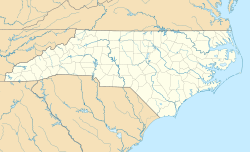Capitol Heights Historic District facts for kids
Quick facts for kids |
|
|
Capitol Heights Historic District
|
|

Houses in Capitol Heights Historic District.
|
|
| Location | Roughly bounded by Penn Rd., North State St., Glascock St., and Madison Rd., Raleigh, North Carolina |
|---|---|
| Area | 30 acres (12 ha) |
| Built by | Wright Construction Co.; Clancy Construction Co. (Clancy & Scott, Inc.); Curtis Construction |
| Architectural style | Minimal Traditional |
| MPS | Post-World War II and Modern Architecture in Raleigh, North Carolina, 1945-1965 |
| NRHP reference No. | 10001112 |
| Added to NRHP | January 3, 2011 |
The Capitol Heights Historic District is a special neighborhood located just north of Raleigh, North Carolina. It's known for its homes built right after World War II. This area is considered a national historic district because it shows how neighborhoods were planned and built during that time.
The district includes 87 important buildings. These homes were mostly built between 1946 and 1949.
Contents
What is Capitol Heights?
A Look at Post-War Homes
The Capitol Heights neighborhood was planned in 1946. It was built because many people needed homes after World War II ended. Soldiers were coming home, and families needed places to live. This led to a big demand for new houses.
The homes in Capitol Heights look very similar. They are usually small, one-story houses with two or three bedrooms. They are built in a style called Minimal Traditional. This style is simple and practical, perfect for building many homes quickly.
Who Built These Homes?
Two main builders, Ernest I. Clancy and George Henry Wright, were in charge of creating Capitol Heights. They worked to build many houses in a short amount of time.
Today, Capitol Heights is one of the best examples of a neighborhood built quickly after the war. It still looks much like it did when it was first built.
Why is Capitol Heights Historic?
Joining the National Register
Because Capitol Heights has kept its original look so well, it was added to the National Register of Historic Places in January 2011. This means it's recognized as an important historical place in the United States. Being on this list helps protect the neighborhood's history and unique style for future generations.



